August 2014
Stones and Scones
Pipes & Drums, Highland Games and Good Eats in Southern Scotland
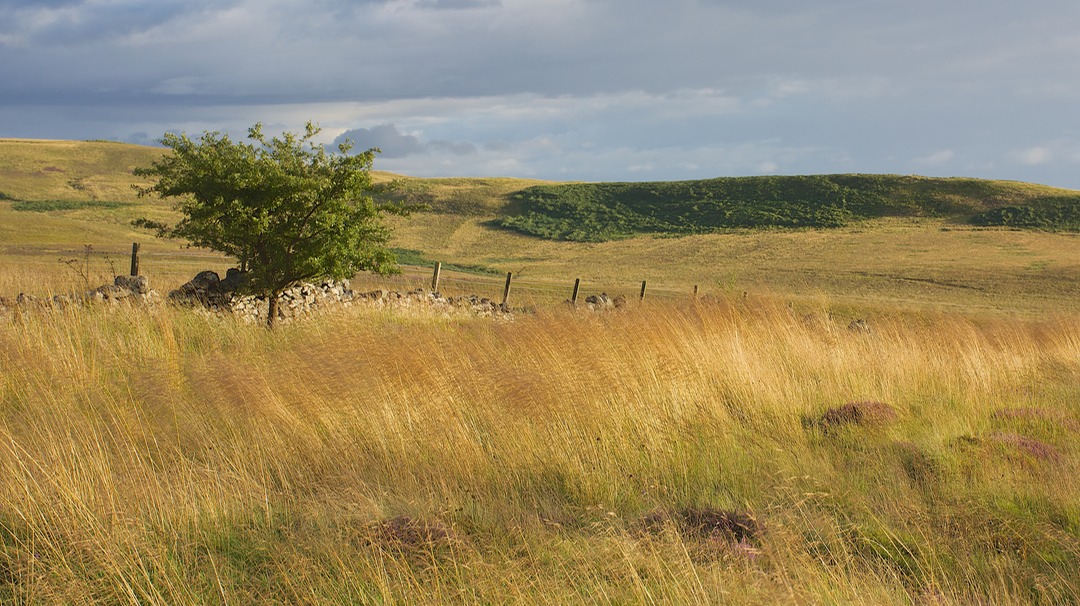
Our time in northern Scotland, the most rural part of the Highlands, was just terrific. We love this country! It is remote, quiet and ever-changingly beautiful. It has a draw to it that makes even dedicated travelers such as ourselves want to buy an old cottage and start cutting some peat for the hearth. It is a simply magical place and we were sad to leave it behind. We might have stayed a lot longer, but we’d made arrangements to meet up with our Glasgow friends in mid-August to attend the International Pipe Band World Championships being held there. So a bit reluctantly, but also excited about what lay ahead, we headed down the hill, the weather slowly improving as we dropped south, moving back toward more urban areas.
While we were in Glasgow, Rick got the truck serviced and got a couple of new tires. Susan and I happily shopped for things, and also took in the excellent Burrell Collection, a museum full of really “choice” items to enjoy. Rick and I like Glasgow; it’s a town that came from rural coastal roots to become a lively historical city with interesting international neighborhoods (and fun groceries), several excellent museums, lovely green spaces, and large, architecturally-interesting mansions created out of the warm dark stone. It even has its own Nelson Column. The city is now coming down off the high of hosting the Commonwealth Games in July; it’s a good time to visit.
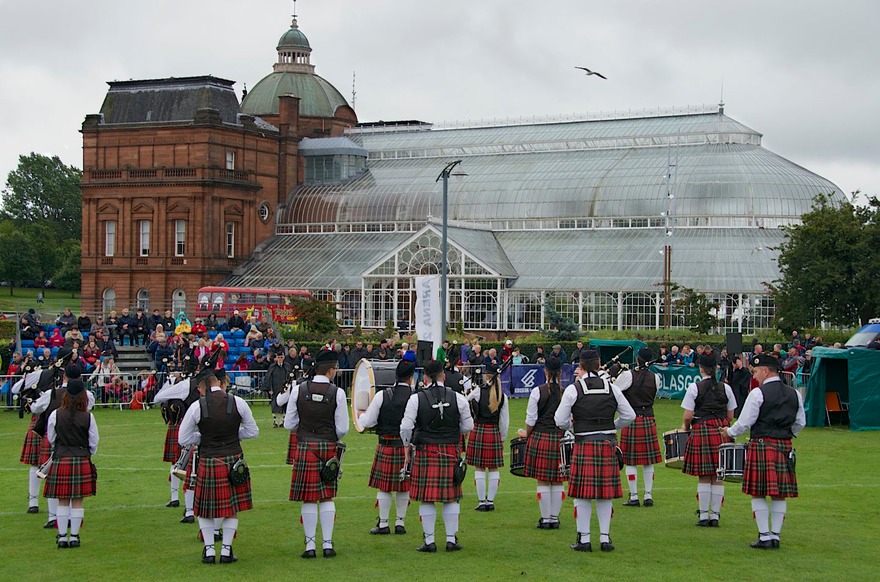
And the day of piping was great fun. There were dozens of competing bands in different classifications, with drummers twirling their padded sticks (in all sorts of colors); big burly guys (and small young ladies as well) noodling away on the pipes; kilts swirling around in colorful tartans; drum majors looking majestic and the bass drum often much larger than the person toting it along – it was quite a sight.
Each band had an entourage; the band members would stand in a circle, practicing, then suddenly pick up the beat, form up and march 10 feet, where they would just as suddenly stop and resume their preparations. A group of followers would troop along behind often holding large matched umbrellas over the players. From time to time someone would move around the circle, standing close to each of the pipers, checking and re-tuning each part of the instrument using electronic tuners.
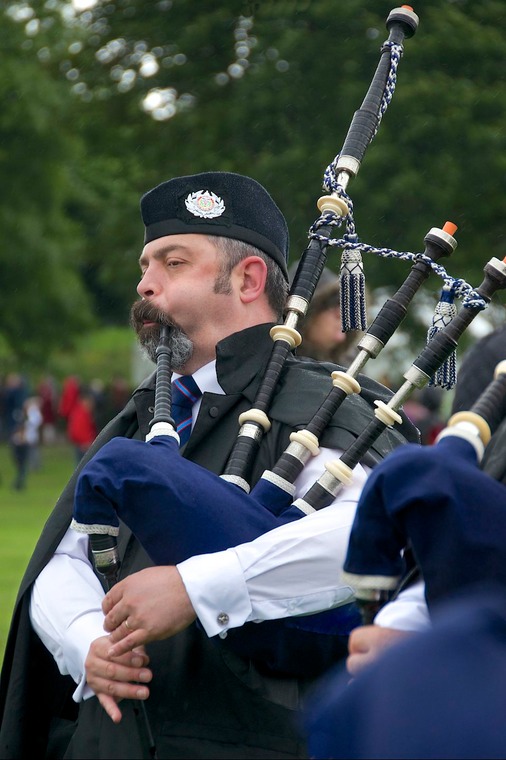
It was all very organized, and, sorry, no points awarded for those of you expressing surprise that bag pipes can be tuned.
And all of this effort was needed. For it was raining off and on all day long – often quite a lot – sometimes horizontally. The band members combated this with long rain capes that covered the bag part but left them room to hold/play/see where they were going. But the rain plays havoc with the tuning and the pipes needed help regularly. It was a great show and the piping was marvelous. Special, and rather pricey, grandstand tickets were needed to really see the competition in the main arena where the Class I groups competed, but we were just fine hanging out at the number two area where the bands seemed, to our ears, to be just as good and we could get much closer to the action.
But the piping was just part of the day. There was yummy food, “smokies” – delicious smoked haddock, and the strangely named ‘tablet’, a wonderful brown sugar delicacy, along with stuff to buy (such as the “Scottish and Prrrr-roud of It” sticker now residing on Tiger’s rear end), of course.
But also fun were the Highland game competitions underway alongside the piping.It seems that you just can’t get a large group of Scots (or is that a group of large Scots?) together without some of them feeling the need to start throwing heavy objects around.
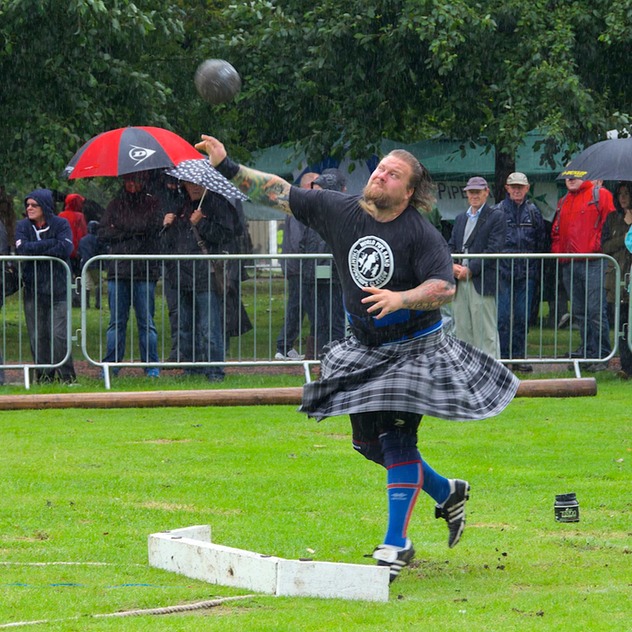
We found ourselves next to the “heavy athletes” events much of the afternoon. They were really interesting. Now these guys are big, I mean really big. And really good. This was a very high-level competition, and often quite thrilling to watch. Among the competitors were several former and current World Champions in various events, and one fellow who was a nine-time Russian champion weight lifter; and you know the Russians have always been serious weight lifters.
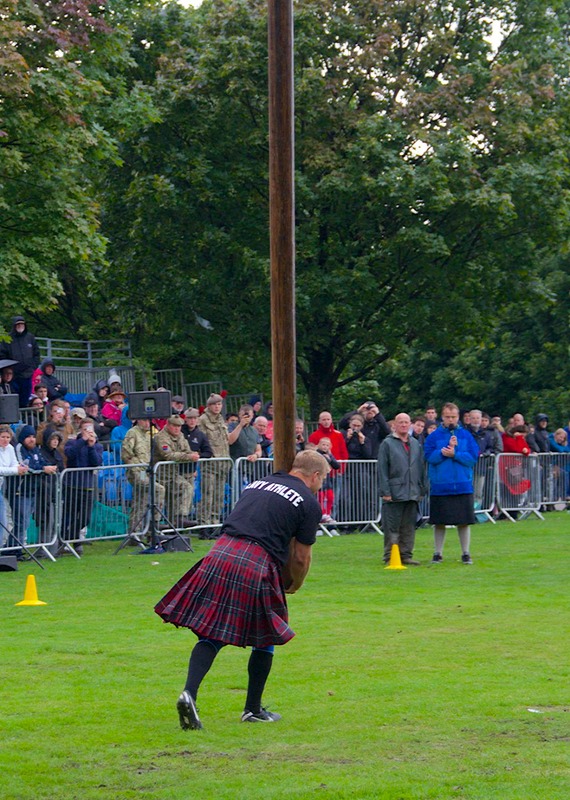
The rain made everything more difficult. We’re sure you can imagine that it’s hard enough to pick up a 160 kilo (350 lb) round, smooth, clean stone when it’s dry; next time try it when it’s too wet to get any purchase. What they were supposed to do was lift it up and put in on top of a barrel that’s at least 5 feet high. Son of a gun! This was intended to be sort of an exhibition, not an actual competition with points awarded, so only a couple of guys tried it. The Russian champion did do it successfully and it was most impressive.
Most interesting of all was the Caber toss. This is the one where they pick up a tree trunk that’s about 18’ long and weighs around 150 lbs, then start running with it until they suddenly pull up short and try to heave the thing so that it lands on its top and then falls forward. If that sounds rather difficult, seeing these big guys trying to do it makes it look even more so. In the end, one of the smaller guys won this event and it was most instructive to watch. It turns out that this particular task is more about speed, balance and proper technique than strength, although that is certainly required as well. After several of the bigger guys had struggled unsuccessfully with the tree, the smaller guy, who turned out to be a two-time British champion in the event, made it look almost easy. It seems there is a lot of technique to tossing the Caber after all. At any rate we enjoyed the games part of the day nearly as much as the piping.
It was a fun if rather wet day. Although it wasn’t raining all the time, it certainly did enough that we were pretty soggy by the time we finally gave up. Could have stayed for the band finals, and the drum major competition was still at it, but we’d all had enough and decided to head for the barn, tired but quite happy.
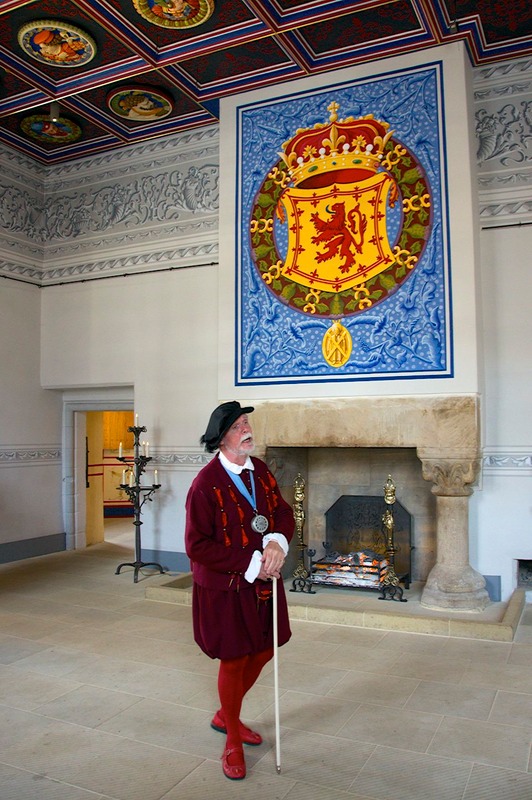
The next day we reluctantly left Glasgow, heading for Stirling and its great castle. We don’t often like something enough to want a return visit, but Stirling is an exception. It’s an old city with a great history; sort of a bit like Edinburgh but more compact and easier to take in. The castle is very special. Most times, castles are either partly in ruins, or tarted up so they look all bright and pretty. Stirling castle looms darkly at you, sort of daring you to take a good explore.
They’d finished renovating a section of the interior in the four years since our last visit, and it was amazing to see what royalty thought was lovely back in the fifteenth century. The rooms were bright and cheerful, if somewhat gaudy.
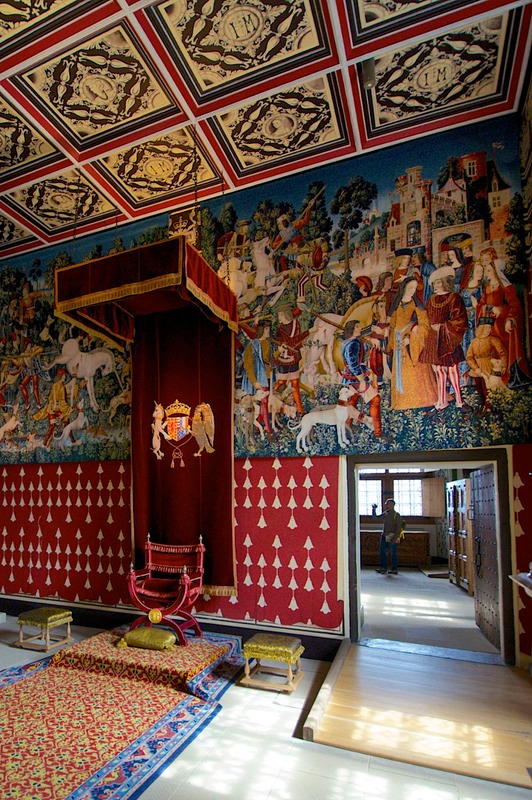
We were interested in seeing the tapestries that Stirling is so known for. Apparently these represent the pinnacle of the weaver’s art and the originals now hang in the Metropolitan Museum of Art in New York City. Wanting to bring Sterling Castle back to its original appearance as the home to Scottish Kings, some years ago a project was begun to completely re-weave all of these famous tapestries. At our first visit in 2010, four of the seven had been completely redone, and were gorgeous. All seven are finished now, and they make up the final finishing touch to the entire restoration. The Great Hall, with its wavy-glassed windows and throne at one end, really evoked medieval life. It was great to have a second visit.
Stirling has lots of monuments, to Robert the Bruce and William Wallace in particular; we wandered and enjoyed, then spent a cold night out on the moors above the city – it got down to a rainy and windy 38 degrees that night, in mid-August!
Near Falkirk is the really neat Antonine Wall, at least what’s left of it. It was built by the Roman Antoninus Pius, and completed in about 140 AD. Less well known than Hadrian’s Wall, it sits a lot further north, along a rough line between Edinburgh and Glasgow, well into Scotland. For about 20 years, it stood as the first line of defense on the northern edge of the Roman Empire. At that time it stood more than 12 meters high, and had fortresses all along its length. Mostly what’s left these days is a ditch, along with a bit of the wall foundation at one location.
I went in search of a place where I could get a good view. When found, it was pretty neat, if you’re into grassy humps of dirt backed up by ditches (I am!). I communed with the Romans and read all the information on how important this more northerly wall had been for a period of time. Cool stuff.
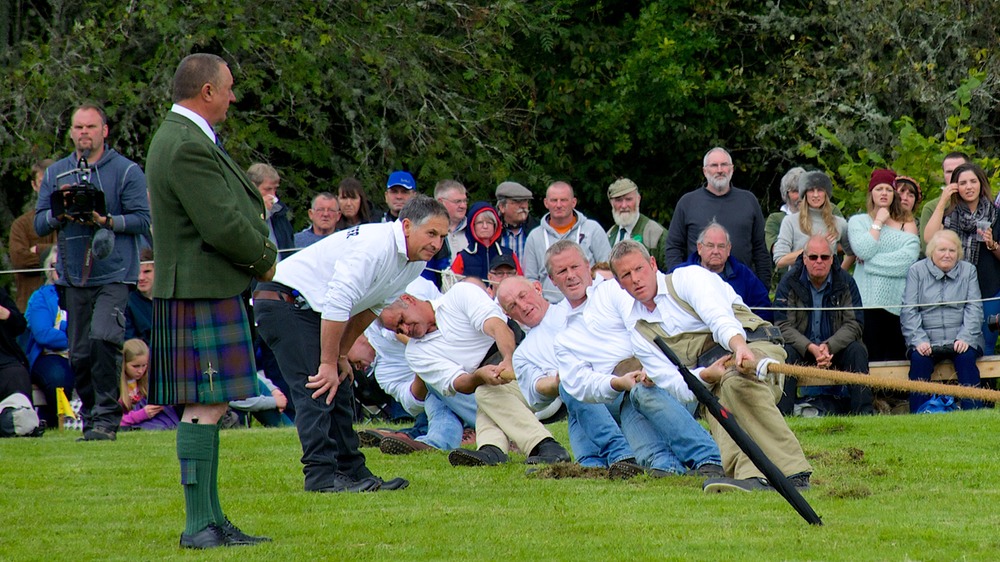
Returning to the current century, it was time to head a bit northeast. Our friends Toni and Berit were flying into Aberdeen and heading to Pitlochry for several days, and it was our plan to join them for a long weekend of exploring together. We’ve hooked up with them in various spots over the years – Berlin, Hamburg, Konya (Turkey) – after first meeting them in Arizona a few years ago. After big hugs, we giggled and ate and explored together for 3 fun days. Pitlochry makes a great base for a visit to the area; it’s both lovely and interesting, and not too cutesy.
The planned highlight was the Strathardle Highland Gathering and Agricultural Show, held a few miles from Pitlochry. The games were a hoot; this was the best such event we’d been to yet. It had a real down home feel. There were tug o’war events, pretty girls leaping about competing in highland dancing, and a parade comprised of tractors/vintage cars/motorcycles/and other oddities that people had polished up for the event.
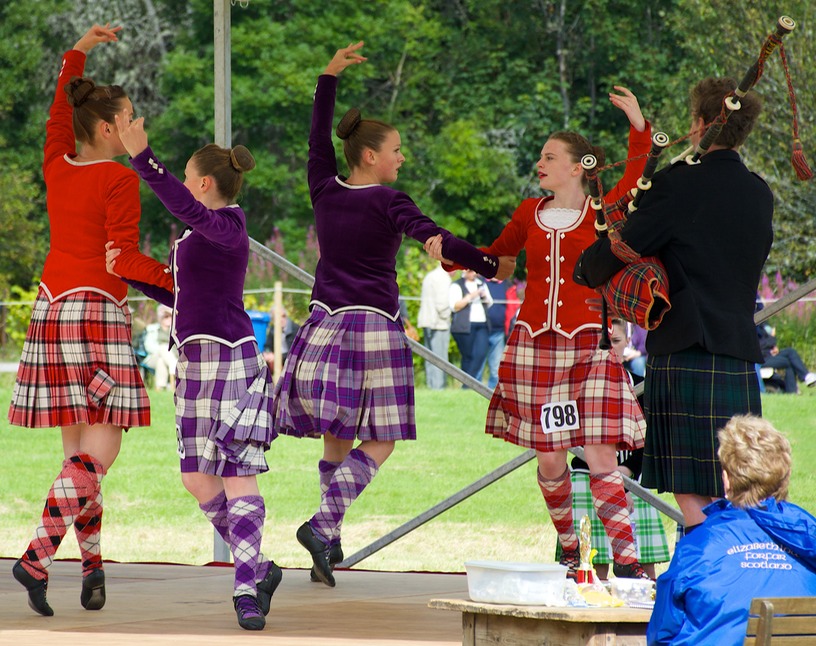
Heavy athlete contests competed with the hay-bale rolling races. There was a home industries tent -- with prizes for the best coleslaw, won by a Mrs. Walker, among other things. And piping. And the Jubilee gathering of the MacThomas clan. Oh and don’t forget the agricultural show: sheep and cattle mostly, but other odds and ends as well. Oh, and a dog show too. And pillow fights. For once it was a beautiful day and we had a wonderful time, topped off with some extraordinary sweets for sale at a charity tent.
We also found time to wander the back roads of this really pretty area of Scotland, past Balmoral Castle (the queen was elsewhere), and along many a nice loch. We spent a very nice couple of hours at 700-year old Blair Castle, which was surprisingly interesting. Not all that large, it had a tremendous number of rooms, mostly filled with family things (well displayed), and with an entry hall absolutely covered with weaponry – and stags’ antlers. We really enjoyed our visit there.
We stopped for a late lunch at a small café in the town of Kinloch Rannoch at the head of Loch Rannoch. Good sandwiches, fun chatting with the waitress and Rick threatening to propose marriage to the pastry chef; the Scots do have a way with scones.
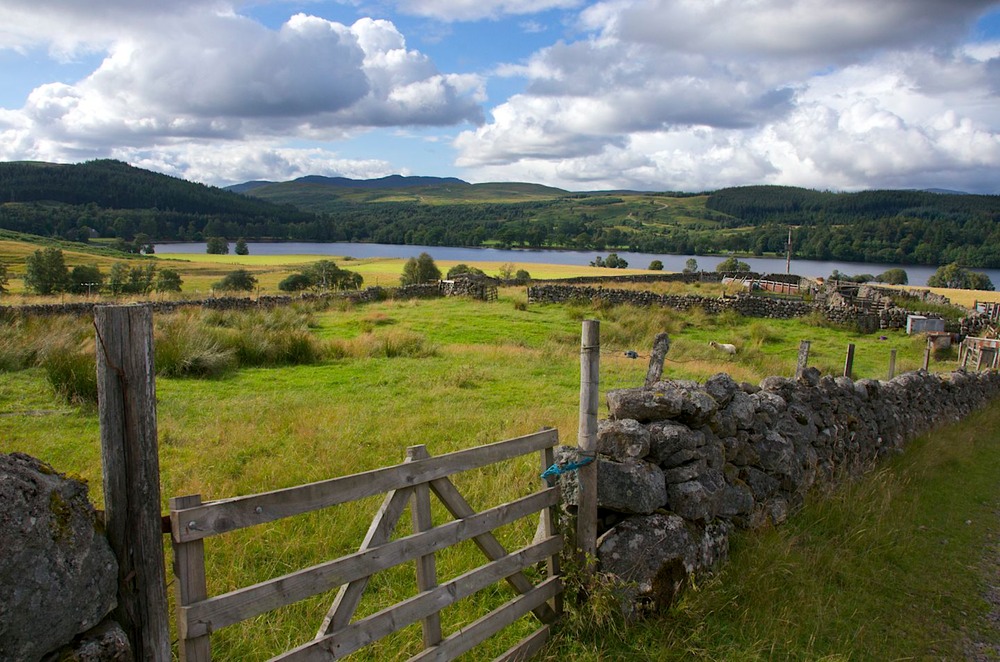
Given a few extra minutes one morning, I looked through a booklet of local activities and information on the area. Along with the usual announcements of bird watching and walking and piping groups, as well as when the weightlifting club meets, there was info on the origin of Iced Tea (and a nice recipe for the making thereof) and – most importantly – how to avoid being bitten by the notorious Highland Midges. I have the directions pinned to the front of my shirt!
Our friends would stay in this part of eastern Scotland for several more days, but we needed to start moving toward England. So, we finally parted in Miegle, home of the amazing Pictish Museum, which we all enjoyed together. The Picts controlled this area in the 9th and 10th centuries and are best known for the groups of carved stones they left behind. We hugged good-by, already thinking of opportunities to meet up next year.
They headed for Arbroath (home of those famous “smokies”), and we moved south through the Edinburgh area, heading back to our favorite spot near the border, at Whiteadder Reservoir. The heather was lush and in full bloom, and we saw tons of pheasants enjoying the recently harvested wheat fields. The weather was good, and we felt right at home here.
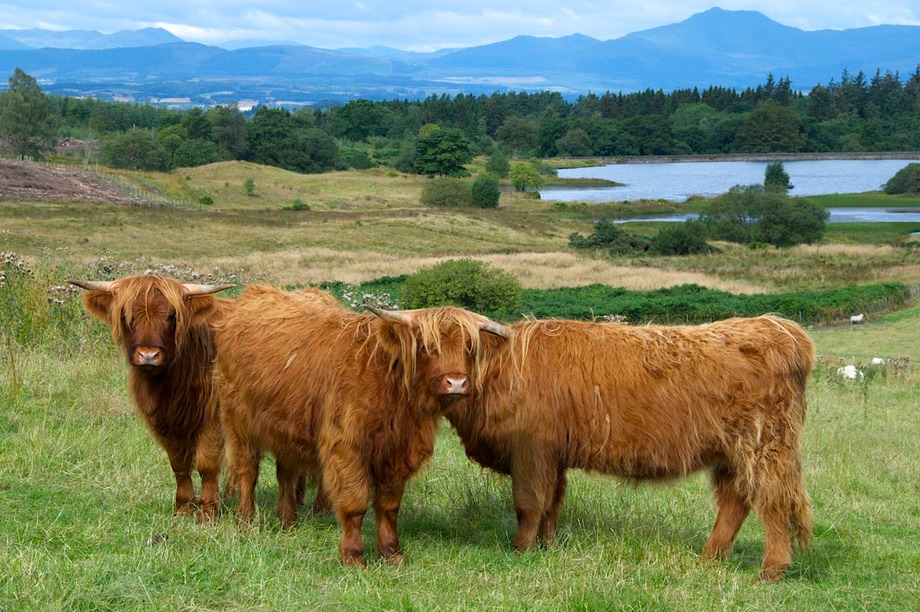
After two days beside the river east of the reservoir, we headed toward Hawick, near the border. We had wanted to stop in at Jedburgh first, but ran out of time. Hawick, (pronounced Hoyk by the Scots) however, got our attention for a bit. It’s a really great spot for buying cashmere and wool sweaters and such. Rick needed a bit of a repair on one we’d bought here on our previous visit so we spent a couple of hours chatting with folks in the various shops, looking for someone to give us some help. No luck actually, but someone managed to pull a bit of yarn for us, giving me something to try my hand at using for the repair (successfully, I might add).
We also spent some time wandering this nice old city; it was the location of a famous (at least locally) battle with the English that took place 500 years ago. Its modern birth came from the woolen mills that still partly support it (along with a lot of tourism). It’s a nice place to wander: the folks are friendly, the town is quite interesting, and the river running through it is a charmer. We spent a happy day there.
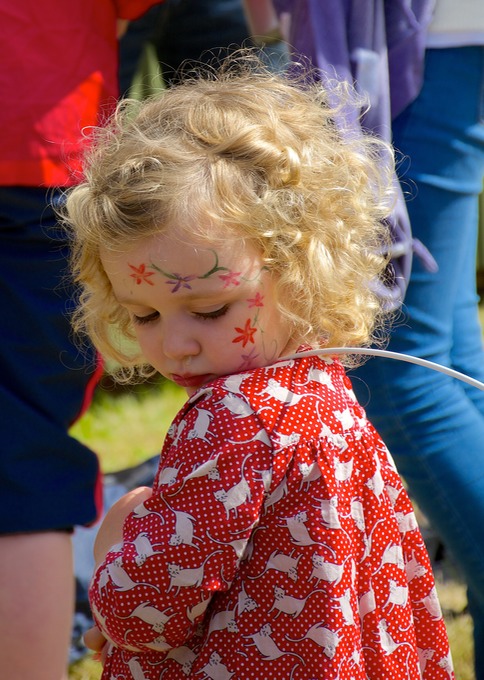
The Borders area region of southern Scotland is quite attractive. Lots of fields and green forests, and small towns with good-looking country churches. We took minor back roads to the border, crossing a multitude of charming small stone bridges over small streams, through cozy little villages, often in a bit of rain. We popped across into England at a lovely view spot over the moors, to the sound of a very wet piper welcoming new arrivals.
We were sorry to leave. Very few countries make us sad to be moving on, but Scotland has become very special to us and we will miss it. Not only is the terrain handsome, and the people polite and open and friendly, but there’s plenty to enjoy. There are great railroad viaducts, small stone bridges just everywhere, enough open land for even the most seclusion-oriented, the best-behaved dogs we’ve seen anywhere, and quite an array of ancient monuments to seek out.
We are interested in seeing the results of the referendum on seeking complete separation from Olde England; at this moment, it seems to be too close to call with the outcome likely to be determined by voter turnout. A lot is at stake; we’re watching it closely.
But we still have things we want to do in England, not the least of which is retrieving some items forgotten the last time we stopped to see cousins Des and Sue. And Dorset and Devon beckon to us as well before we hop a ferry back to France. So off we go. More soon.
Rick and Kathy